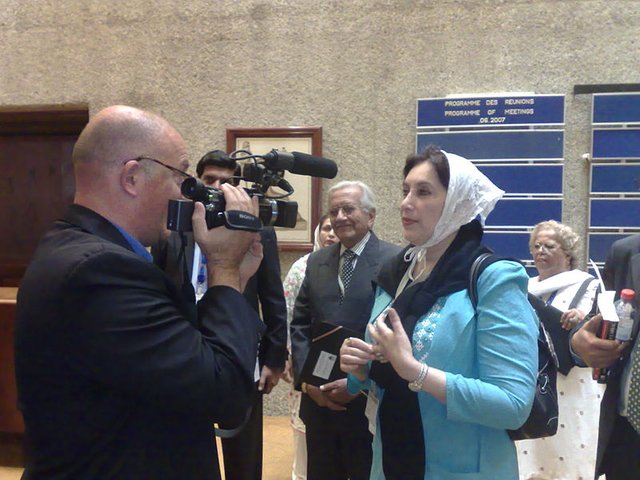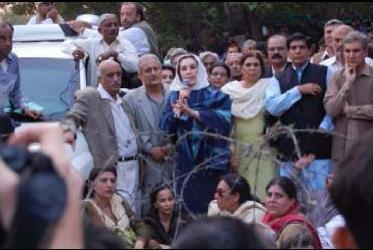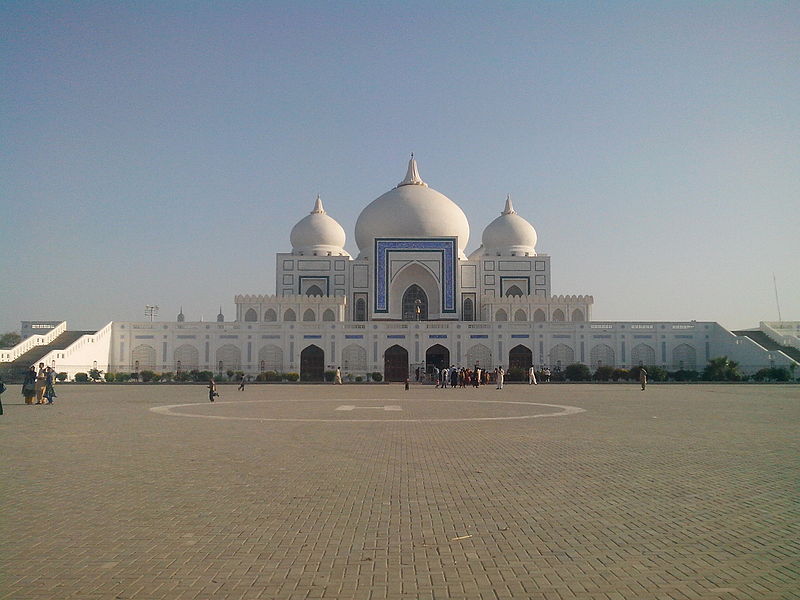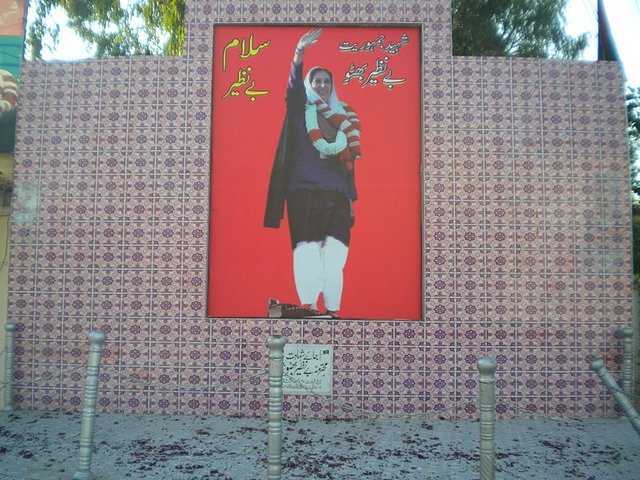The US and UK were losing faith with Musharraf.[292] His domestic popularity was slipping; a mid-2007 poll gave him only a 26% approval rating.[293] In 2007, mass anti-Musharraf protests broke out in what was known as the Lawyers' Movement.[292] Pakistan was also experiencing growing levels of violence from Islamist militants, such as the Siege of Lal Masjid.[292] Official figures held that 8 suicide bombings took place in 2006 and 44 in 2007.[292] The US government increasingly saw Bhutto as an important figure who could help to constrain Pakistan's domestic problems.[294] They nevertheless wanted a power sharing deal and did not want Musharraf removed from power completely, regarding him as a vital ally in their War on Terror.[295]

Assisted by Luis Ayala, the secretary-general of the Socialist International, in 2006 Bhutto and Nawaz began a process of reconciliation.[296] Ayala believed that this was a prerequisite for ensuring Pakistan's transition back to democratic elections.[296] Both where then living in London, not far from one another.[296] Facilitated by the lawyer Aitzaz Ahsan, the pair developed a joint plan of action.[296] This entailed establishing a committee consisting of four Pakistani senators, two from the PPP and two from the Pakistan Muslim League (Nawaz).[296] The pair's reconciliation was formalised with the signing of a Charter of Democracy in May 2007.[297] Henceforth, Bhutto avoided openly criticising Nawaz as she once had.[298]
Concerned about the instability of their ally, the U.S. government pushed Musharraf to meet with Bhutto and come to an arrangement that might strengthen his legitimacy.[299] This dialogue was also pushed for by the UK government.[300] In January 2007, Musharraf held his first meeting with Bhutto at a hotel in Abu Dhabi.[301] The pair underwent follow-up talks in June.[262] As a result of their discussions, it was agreed that the Pakistani authorities would drop all charges of corruption against both Bhutto and her husband.[302] It was also agreed that if Musharraf stepped down from his military positions and was elected as a civilian President, then Bhutto would be willing to serve under him as Prime Minister.[303] As part of their negotiations, Musharraf also agreed to lift the ban on individuals serving more than two terms as Prime Minister.[304] Many of Musharraf's close allies had reservations about his concessions to Bhutto.[305]
The US' Condoleezza Rice and the UK's Jack Straw worked together to ensure a transition back to electoral democracy in Pakistan.[300] In August 2007, the U.S. ambassador to the United Nations, Zalmay Khalizad, has several meetings with Bhutto in New York City.[299] In the city, Bhutto also gave a public talk at the Council of Foreign Relations.[306] Bhutto and Khalizad also travelled to a luncheon in Aspen, Colorado to meet with prominent U.S. political and business leaders.[299] In October 2007, Musharraf was elected President by Pakistan's parliament. In keeping with the agreement made by Bhutto and Musharraf, the PPP representatives abstained rather than voting against Musharraf's nomination.[307]
Return to Pakistan and the assassination attempt: October–December 2007

Bhutto returned to Pakistan in October 2007, arriving in Karachi.[308] Musharraf was annoyed at her arrival, having requested that she only return after the election.[309] It was widely thought that she had a strong chance of becoming the country's next Prime Minister in the 2008 national elections.[310] She described the main problem facing her country as the clash between "moderation and extremism",[311] and was pessimistic about her safety.[312] Musharraf himself had survived several assassination attempts by Islamist militants,[313] and warned Bhutto that she too would be a target.[314] She requested that the US or UK take responsibility for her security, but they refused, and her security detail was instead organised by Musharraf.[315]
While her cavalcade was making its way through a crowd in Karachi, two bombs went off, killing 149 and injuring 402. Bhutto herself was physically unharmed.[316] Bhutto alleged that there were four suicide squads that had been dispatched to eliminate her and that there were key officials in the government involved in the plot; she sent a list naming these officials to Musharraf.[317][318] Bhutto requested that Musharraf bring in the British Scotland Yard or U.S. Federal Bureau of Investigation to investigate the crime, but he refused.[319]
Posters of Benazir for sale in Lahore in the run-up to 2008 elections.

Relations between the pair were further strained when Musharraf declared a state of emergency and suspended the constitution in November.[320] The PPP and PML-N launched protests at Musharraf's actions.[321] In November, Bhutto was briefly placed under house arrest.[321] She then publicly denounced Musharraf, fearing that any association with him would damage her credibility.[322] On 16 December, Musharraf lifted the emergency measures and then retired as army chief.[323]
On 24 November 2007, Bhutto filed her nomination papers for January's Parliamentary elections; two days later, she filed papers in the Larkana constituency for two regular seats. She did so as former Pakistani Prime Minister Nawaz Sharif, following seven years of exile in Saudi Arabia, made his much-contested return to Pakistan and bid for candidacy.[324] When sworn in again on 30 November 2007, this time as a civilian president after relinquishing his post as military chief, Musharraf announced his plan to lift the Pakistan's state of emergency rule on 16 December. Bhutto welcomed the announcement and launched a manifesto outlining her party's domestic issues. Bhutto told journalists in Islamabad that her party, the PPP, would focus on "the five E's": employment, education, energy, environment, equality.[325][326] The PPP's manifesto called for greater civilian oversight of, and restrictions on, the military and intelligence agencies.[327] They also vowed to rid the intelligence services of elements driven by political or religious motives.[327]
On 4 December 2007, Bhutto met with Nawaz Sharif to publicise their demand that Musharraf fulfill his promise to lift the state of emergency before January's parliamentary elections, threatening to boycott the vote if he failed to comply. They promised to assemble a committee that would present to Musharraf the list of demands upon which their participation in the election was contingent.[328][329]
Mausoleum of Bhutto family at the family graveyard Garhi Khuda Bakhsh, where Benazir Bhutto and several members of her family are buried

On the morning of 27 December 2007, Bhutto met with Afghan President Hamid Karzai.[330] In the afternoon, she gave a speech at a PPP rally held in Rawalpindi's Liaquat National Bagh.[331] On leaving in a bulletproof vehicle, she opened the car's escape hatch and stood up to wave to the surrounding crowds.[332] A man stood within two to three metres of the car, fired three gunshots at her, and detonated a suicide vest packed with ball bearings.[333] Bhutto was fatally injured; reports differ as to whether she was hit by bullets or by shrapnel from the explosion.[334] Bhutto was rushed to Rawalpindi General Hospital but was clinically dead on arrival and attempts at resuscitation were unsuccessful.[335] No autopsy was conducted, and the body was swiftly transported to Chaklala Air Base.[336] The following day, she was buried next to her father in the Bhutto family mausoleum, Garhi Khuda Baksh, her family graveyard near Larkana.[337] PPP supporters rioted in various parts of Pakistan.[338]
Authorities claimed that the assassin had been a teenage boy from South Waziristan.[339] They claimed to have proof that the attack had been masterminded by Baitullah Mehsud, leader of the Pakistani Taliban.[340][341] The U.S. Central Intelligence Agency concurred that this was probable;[342] Mehsud believed that Bhutto's pro-American and secularist agenda would undermine the Pakistani Taliban's control of South Waziristan and hinder the growth of Sunni Islamist radicalism.[343] Mehsud denied the accusation,[344] with al-Qaeda spokesman Mustafa Abu al-Yazid instead claiming that his organisation had carried out the killing on the order of its second-in-command, Ayman al-Zawahiri.[343] The PPP accused the government of a cover-up,[345] with several PPP figures claiming that Bhutto had been killed by a sniper linked to the intelligence agencies.[346] Within Pakistan, there was also public speculation that the attack might have been masterminded by India or the United States.[347] Musharraf agreed to invite Britain's Scotland Yard to investigate the assassination.[348] Requests for the body to be exhumed for an autopsy were rejected by Zardari.[349]
Memorial at the site of the assassination

The election was postponed from January to February 2008,[350] and was won by a coalition established between the PPP and the Pakistan Muslim League (N).[350] The new coalition put forth Yousuf Raza Gilani as Prime Minister.[350] Musharraf, facing likely impeachment, resigned as President in August.[350] He fled to London although, in February 2011, a Rawalpindi court issued a subpoena for him on the grounds that he had not acted on known threats to Bhutto and had provided insufficient security to protect her.[351] In Bhutto's political will, she had designated her husband Asif Ali Zardari as her political successor, but Zardari made their nineteen-year-old son, Bilawal, the Chairman of the PPP [352][353][354] and he became co-chair of the PPP.[350] In September 2008, Zardari was elected President of Pakistan by the country's electoral college.[355]
As President, Zardari called for a United Nations investigation into his wife's assassination.[346] In 2009, Secretary General Ban Ki-moon established a three-person team to lead the investigation comprising the Chilean Heraldo Muñoz, Irish Peter FitzGerald, and Indonesian Marzuki Darusman.[356] Although it was not in the commission's remit to identify a culprit,[357] Muñoz later expressed the view that the assassination was likely carried out by the Pakistani Taliban, perhaps with the support of Mehsud, and that they may well have been assisted by rogue elements in the country's intelligence agencies.[358] He also expressed the view that the original police investigation had been deliberately botched.[359] In February 2012, the Pakistani official enquiry issued its final report, placing responsibility for the attack with 27 different militant groups.[360] In May 2013, the state's main prosecutor in the Bhutto case, Zulfikar Ali, was himself assassinated in Islamabad.[351] There was never a smoking gun in the Bhutto investigation.[358] Many in Pakistan had reasons for wanting Bhutto dead;[358] her killing was advantageous to both the military establishment and to the Islamic fundamentalists who despised her.[361]